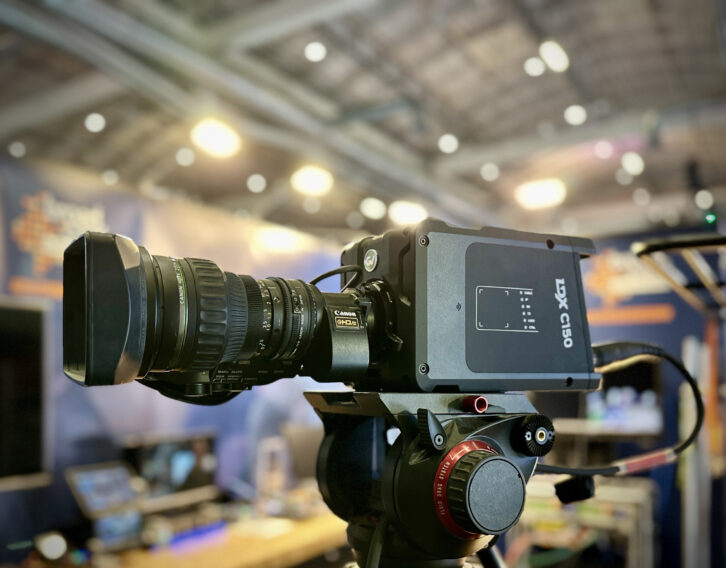In an industry that moves ever forward, there is rarely much opportunity to look back. But as Grass Valley marks the 65th anniversary of its founding in April 1959, ahead of what promises to be another highly dynamic instalment of the NAB Show, it’s hard to resist asking some of today’s GV executives about what they regard as the key milestones of the past 6.5 decades.
On the camera side of the business, director of product marketing Klaus Weber highlights several innovations including the first market launch of CMOS sensors with global shutter. “Only this technology made it possible to realise HD cameras and later also UHD cameras with the necessary light sensitivity, and only these sensors made it possible to realise both super slow-motion cameras and HDR operation with the best quality,” he says.
Examining GV’s history of video production switcher development, VP for switchers Greg Huttie pinpoints “from the tech point of view an additive trio were introduced directly into switcher processing frames: 2110 IP I/O capability, full raster UHD 4K 2160p at a large scale, and HDR processing. Through this integration, along with user interfaces built from the technical director’s point of view multi-format productions could be realised with greater flexibly, cost-effectiveness, and without creative compromise.”
But whilst it’s nice to look back, the slew of announcements that Grass Valley has planned for NAB Show 2024 confirms that the company’s commitment to media technology innovation is very much ongoing.
Elevating broadcast camera technology

Headlining GV’s broadcast camera presence at NAB will be several significant enhancements to the LDX 100 Series platform that underscore the company’s commitment to addressing the complex demands of live production environments. The latest updates include:
- Advanced HDR/SDR Operations: Integrated LUT processing in all LDX 100 series cameras ensures optimal HDR/SDR signal quality directly from the camera head and base station, reducing the need for external converters. Notes Weber: “In the area of HDR/SDR productions, there are more and more applications that require an efficient and cost-effective workflow, and the LUT processing integrated into the cameras meets exactly these requirements.”
- Improved Design for Enhanced Usability: Modifications to the shoulder pad, handgrip and housing materials have made the camera lighter and more ergonomic, while airflow optimisations have resolved previous heat generation issues.
- Innovative High-Speed Shooting: New capabilities allow for 6x 1080p shooting with native UHD resolution of the live signal output, supported in both NativeIP and XCU base station operations. Weber says: “In the area of native UHD productions, there is an increasing desire to integrate super slow-motion cameras with the best possible image quality into the workflow. The native UHD signal output for the live signal in 6x 3G super slow-motion mode addresses this requirement.”
- Wireless Camera Version: A new camera model optimised for wireless operation paves the way for seamless integration with wireless transmission technologies and cloud-based production solutions. Weber explains: “The launch of a wireless camera in the LDX 100 series fulfils users’ desire for a flexible camera that can be used for a wide range of applications, including wireless cameras in sports or entertainment productions, as well as remote production applications with wireless integration into IP infrastructures.”
Redefining production switching
The K-Frame XP video production switcher series is already the first choice for high-profile live productions thanks to its exceptional capabilities and versatility. But at the NAB Show, Grass Valley will introduce multiple new enhancements to the series, including:
- Advanced IP I/O boards: New generation IP I/O boards with JPEG XS encoding/decoding capability without loss of I/O count, 100GbE QSFP and 25GbE SFP ports, plus extended buffers in 2160p.
- Colour Mapping HDR<>SDR / 3D LUT Translation: Internal mapping and translation within the video processing frame to support the most demanding event coverage, assisting productions in handling the ever-increasing variety of programme outputs required.
- ClipStore II: A new generation of ClipStore offering up to 4-channels of playback and record in all formats including UHD 4K 2160p with both SDI and IP connections.
Reflecting on the new additions, Huttie remarks: “The expanded capabilities of the IP connection and the additional possibility of supporting compressed signals in the video production switches meet the requirements of users in the most demanding applications. The same applies to the integration of LUT processing, which makes HDR/SDR productions with mixed signal sources a simple affair.”
These enhancements are also likely to be pressed into service during this year’s very busy schedule of sporting events. “For major sports productions scheduled for summer 2024, these extended functionalities will be used to make the workflows as efficient as possible,” he adds.
The rise (and rise) of IP and SaaS
More generally, Grass Valley is continuing to witness increased adoption of IP infrastructures, SaaS applications and cloud-based media environments, as supported by innovations including the AMPP (Agile Media Processing Platform) and GV Media Universe, which is Grass Valley’s groundbreaking vision for transitioning to the software- and cloud-based future of content creation and distribution.
“We are seeing increasing acceptance and use of IP infrastructures and SaaS applications in all areas of media and entertainment applications, with almost all new investments using these technologies in some form,” confirms Huttie. “There are also initial examples that could either be achieved much more efficiently and cost-effectively through the use of IP infrastructures and SaaS applications or were only possible thanks to these solutions. Through our AMPP platform, we offer the best possible integration of SaaS applications in all areas of the production environment. One to take a good look at during NAB is the new software-based Maverik X production switcher.”
Finally, the NAB 2024 showcase will certainly not represent the full extent of GV’s innovations for this year, with Huttie revealing that the company is at present working on “many other exciting new developments and advancements. These include both hardware and software solutions and will be announced later this year as they become available.”
NAB Show 2024 attendees can visit the Grass Valley stand (C2308) to experience these innovations first-hand and explore its complete portfolio of cameras, production switchers, multiviewers, routers, processing, asset management and live playout systems.





